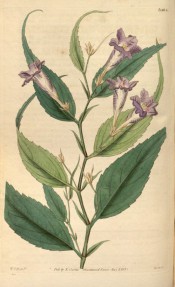Strobilanthes anisophylla T.Anders.
Frost tender, evergreen sub-shrub with unequal pairs of lance-shaped, toothed leaves, the longer to 9cm long, and tubular blue flowers, borne in cone-shaped inflorescences in spring and winter. To 2m. [RHSD].
Horticultural & Botanical History
First botanically described as Ruellia anisophylla by Wallich in Hooker’s Exotic Flora in 1827 [Exotic Flora vol.3, t.191/1827]. Transferred to the genus Goldfussia by Nees in 1832 [Wallich vol.3, p.88/1832] and to Strobilanthes by Thomas Anderson in 1865 [Cat. Pl. Roy. Bot. Gard. Calcutta, 1861-64 p.43/1864]. Although the latter name is now commonly used it is not totally accepted as valid with Goldfussia sometimes preferred.
‘This beautiful plant [Goldfussia anisophylla] was found by Francis de Sylva, at Silhet, and through Dr. Wallich introduced to European gardens, where it is a great ornament to our stoves, flowering during the winter and spring months. The flowers are handsome, but in a measure concealed by the distichous foliage, under which they seem to insinuate themselves, though they originate in the upper axils of the leaf.’ [BM t.3404/1835]. Introduced to Britain in 1823. [JD]. MB p.121/1841.
History at Camden Park
Listed only in the 1850 and 1857 catalogues [T.530/1850].
Notes
Published Feb 22, 2010 - 11:22 AM | Last updated Apr 21, 2011 - 05:28 PM
| Family | Acanthaceae |
|---|---|
| Category | |
| Region of origin | Asia |
| Synonyms |
|
| Common Name | |
| Name in the Camden Park Record |
Goldfussia anisophylla |
| Confidence level | high |
